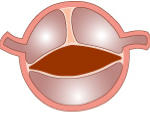


Disclaimer Privacy Policy
Copyright (c) 2021 Bicuspid Aortic Foundation, All Rights Reserved


Creating a Climate of Hope, an Atmosphere of Caring, and Information for All

Bicuspid Aortic Valve
Open BAV
The opening of a BAV resembles the open mouth of a fish, leading to the term “fish mouth” valve.
BAV and the Greatest Dangers
Not everything is understood, but some of the greatest
dangers are known.
While not everything is understood about bicuspid aortic
disease, some of the most dangerous aspects of it are
known. This disease can present the greatest threat to life
due to abnormalities that are seen in the heart valves, aorta,
and vessels of the head and neck.
For those with abnormal aortic valves, as with any heart
valve condition, it is important to obtain expert medical care.
However, focusing on the valve alone is not enough.
It is not safe to think that if a bicuspid aortic valve has
been removed, repaired, or continues to work well that
everything is all right, because there is still a risk of
aortic dissection or rupture.
Ignoring other potential affects of this disease can be
dangerous. Aneurysm and dissection are serious, life-
threatening conditions.
For those with replaced valves, prosthetic (artificial)
heart valves are a good but not perfect solution and
require lifelong monitoring and potentially another
replacement.
Repair of the bicuspid aortic valve may be offered in
some situations, but the repaired valve must also be
monitored.
There is also a risk of developing endocarditis.
Even less is known about the apparently trileaflet members
of BAV families. More studies are needed that encompass
family members who are apparently trileaflet, in order to
better understand them.

Bicuspid Aortic Valve
Closed BAV
When closed, it may be difficult to distinguish a BAV from an aortic valve with all three leaflets.
Tricuspid Aortic Valve
Closed TAV
A normal aortic valve has three leaflets or cusps. Pictured here is a TAV with the leaflets closed. The opening of a TAV is shaped like a triangle.
Aortic Aneurysm
The aorta in those from BAV
families may be enlarged
and balloon out, which is
called an aneurysm.


- Aorta
- BAV and Other Heart Valves
- Blood Pressure
- Exercise/Weight Lifting
- Featured Papers
- Guidelines
- Familial TAAD
- History
- Honoring Dr. M.E. Abbott
- Pictures (graphic content)
- Pictures Valvular Strand, Aneurysm (graphic)
- Prosthetic Heart Valves
- Scientific Awards
- Spotlight on Research - Coming Soon
- Video (graphic content)





































